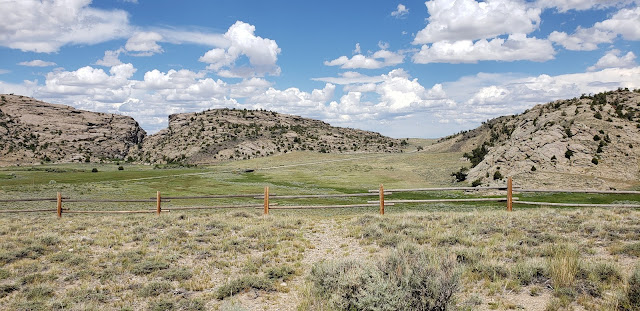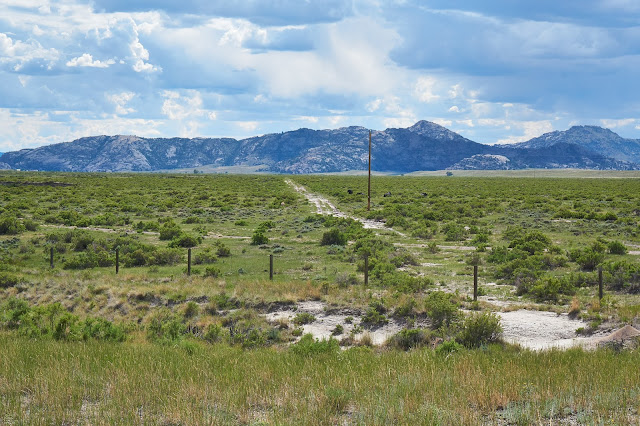Because shipping seems to be a little slower now due to the recovering economy, tracking info showed the windshield stalled in Denver for an extra day. That gave us time while in Rawlins to make a day trip out to Independence Rock. Located on Wyoming Highway 220, this landmark was the midway point on the Oregon Trail, the Mormon Trail, The Overland Express Trail and the California Trail. We enjoyed a half day here exploring Martin's Cove, the Devil's Gate and Independence Rock all located within about 3 miles.
The first stop on Wyoming Highway 220 about 2 miles south of Independence Rock is Martin's Cove. To learn more about Martin's Cove and its history, click HERE. This area was the campsite location used by the Martin Handcart Company after the rescue of 2 of their companies in 1856. Unfortunately because of several factors: bad weather, lack of food, illness, exhaustion and the decision to leave too late in the year, it all lead to the loss of between 135 and 150 emigrant lives here. This was the greatest loss of life from any single event during the entire Westward migration period.
 |
| Entrance way to Martin's Cove |
Inside the museum was this beautiful stone fireplace consisting of different types of rock. Tom Sun's wife loved to collect rocks, even receiving some as gifts from travelers as they passed by their homestead. She used her rock collection to create this unusual fireplace.
 |
| Top right, that's a petrified Wooly Mammoth tusk, Lower right, obsidian rock. |
This Evans Lever Action Rifle, made in 1873, was a gift to Tom Sun Sr. from Buffalo Bill. Their early friendship was instrumental in developing Buffalo Bill's sharp shooting skills.
 |
| These small granite monuments mark the Oregon Trail Crossing and the unfortunate loss of life of the pioneers. These were in the parking lot at Martin's Cove. |
The Devil's Gate landmark can be seen on the left below and the road path is the actual Trail that travels through Rattlesnake Pass. All travelers on their way West passed by here.
A second overlook on Hwy 220 offers another view of the westward travelers' Trails. Imagine wagon trains of emigrants, fur trappers on horses, people pulling and pushing handcarts and the Overland Stage heading west in search of a better, more productive life.
A view of Rattlesnake Pass.
Landmarks: the Devil's Gate and Rattlesnake Pass. Travelers knew they were on the right trail when they saw that crack in the rock.
 | |
| Walking along the paved walkway at the Devil's Gate Overlook I spotted a snake skin in the grass. We moved right along! |
Continuing north on Hwy 220, we spot the Independence Rock.
The historic landmark now hosts a modern rest area with facilities for travelers.
White stick markers denote the 4 different Trail pathways. If you look closely you can still see evidence (depressed earth) where the Trail goes to the right.
The state of Wyoming provides a paved walking path to Independence Rock and the scratched inscriptions made by emigrants.
Ronnie was tempted to climb the rock to see the more preserved inscriptions on top but it's the middle of the day when we're here and the temperature is too warm. We did see several young families climb it however.
In order to protect what is left of the emigrants' carvings, this metal fence keeps people away from the rock face. Due to natural weathering, these inscriptions are difficult to see now. Unfortunately they will not be here many more years.
We did see plaques added to the rock denoting significant inscriptions. Carving names and dates was a way the emigrants communicated to other passing travelers and family that they had made it this far.
All of these markers and the carved inscriptions are protected by a high fence and barbed wire. There are more carved inscriptions on the top of Independence Rock, they can be found under rock outcroppings and better weather protected areas of the rock. Unfortunately you've got to climb to the top of the rock to see them.
This plaque honors Oregon Trail blazer Ezra Meeker. To learn more about him and his importance to the preservation of the Oregon Trail landmarks, click HERE,
Granite marker installed by the state of Wyoming in 1914.
Emigrant inscriptions are still visible today but barely. We could only make out a letter here and there.
Remnants of an old highway pass by Independence Rock, it goes off into the distance.
One more view of what the travelers on the Oregon Trail saw as they left Independence Rock headed towards Rattlesnake Pass.
This rancher's road seems to follow the Trail once it crosses Hwy 220.
More later from
Sheridan, Wyoming.





























No comments:
Post a Comment